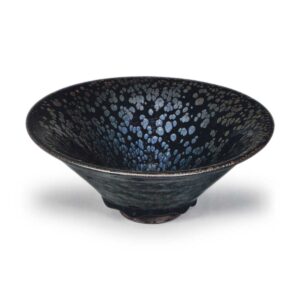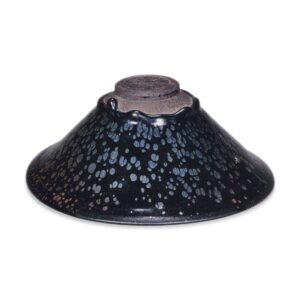

Important Cultural Property
Height: 7.7cm
Diameter: 19.4cm
Foot diameter: 4.9cm
Height: 0.7cm
This bowl, made at Jian kilns in Fujian province during the Southern Song dynasty, has a rim that curves outwards, and large oil droplets are beautifully floating on the entire inside and outside surface. It is said that the kiln site of Jian kilns is covered in countless Tenmoku shards, and the majority of these are tea bowl shards. Apart from tea bowls, there are only two other types of shards found here: bowl shards, which are about the same size as this bowl, and small bowls with a diameter of around 10cm.
There are very few Jian bowls left, and I have only seen a few of them. There are very few Yudeki Tenmoku bowls, and as far as I know, the two bowls in the Freer Gallery of Art in Washington and this bowl are considered to be the two best examples of this type of bowl from East and West. The clay, shape and workmanship are almost identical, but the grains in the Freer Gallery of Art bowl are smaller, while the grains in this bowl from Seikado Bunko are larger. In addition, the Freer bowl does not have an inscription on the underside, but this bowl has the character “新” (shin, meaning “new”) inscribed on the underside of the foot ring.
Compared to Yohen Tenmoku, Yodeki Tenmoku is a type of bowl that has been produced in large numbers, and in particular, there are quite a lot of Yodeki bowls produced in the kilns of the North China region. , and there are also Ming and Qing dynasty pieces and modern pieces, but the number of Jian ware oil spots is far smaller than the number of oil spots from the kilns of northern China, and only a few tea bowls have survived.
When the temperature of the kiln is high, the glaze surface boils and bubbles, and when the bubbles evaporate and leave dents, iron crystals form where the iron rust from the glaze surface collects. If it cools slowly at a temperature similar to that at the time of firing, it becomes an oil spot, but if the temperature is higher than that, it becomes a flow and becomes a haikou bowl, or, as it is commonly called in Japan, a kome-me. There are many haikou bowls and even more kakitenmoku bowls, but there are very few that stop at the oil spot stage.
The size of the oil spot is determined by the thickness of the glaze. If the glaze is thick, the oil spot will be large, and if the glaze is thin, the oil spot will be small. Both are considered to be rare masterpieces, but the oil spots on the Seikado Bunko Art Museum pieces are large, and the oil spots on the Freer Gallery of Art pieces are small, because the glaze on the Seikado Bunko Art Museum pieces is thin.
Even if they are both yudeki, the yudeki from the kilns in North China have a brownish tinge, while the yudeki from the Jian kilns have a bluish-black tinge. This is probably because the kilns in northern China are fired with coal, and so many of the pieces are fired with oxidizing flames, while the Jian kilns are fired with wood, and so many of the pieces are fired in a reducing atmosphere. In addition, the Jian glazes contain impurities such as cobalt, so almost all of the yohen and yudeki glazes are jet black.
This bowl is also made from clay with a slight iron content, and the jet-black glaze is thickly applied, with large oil spots beautifully floating on the inside and outside. It is thickly made, with a wide mouth, a slightly curved rim, and a small, low foot ring.
The inside of the foot ring has been slightly carved, and the character “新” (meaning “new”) is engraved on it. From the remains of the Ken kiln, tenmoku shards with inscriptions such as “sei”, “shin”, “shu”, “ryu”, “kougo”, “ka”, “dai”, “ichi”, “ni”, “shi”, “hachi”, “go”, “hon”, “kou”, “shin”, etc. have been discovered, but it is still unclear today what “shin” means.



